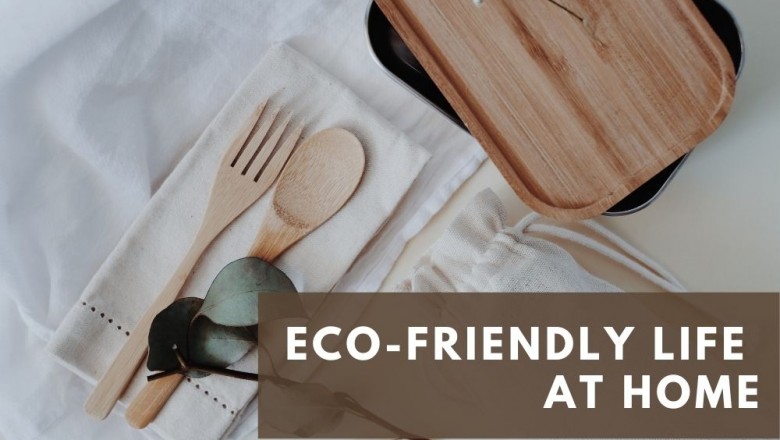views

At present times we are already surrounded by pollution, toxic air, synthetic eatables, and a lot of things that are harmful to us. Intentionally or unintentionally we have been consuming and using products that aren’t safe but at the same time, we have no other options. So we can’t help but opt for things that are easily available in the market. Sustainability has become a burning issue and relevantly so. It is not only that we harm but our environment as well when we choose products that leave behind toxic by-products. In order to live a healthy life, it has to be a process that indulges the goodwill of nature along with us.
Cotton is the most commonly used fabric in the summers specially. Even in another season that is the most desired and used fabric. Why so? It is because of its comfortable and breathable nature and also its availability in the market. But do we ever think of it from a sustainable point of view? This article doesn’t mean to discard or bad-mouth cotton fabrics completely but certainly, wants to bring to notice that choosing natural fabrics could help you lead a safe and sustainable life.
Why choose natural over synthetic fabric?
It is possible that when some people think of natural fabrics and fibers, they connect themselves with coarse, crude, and rucksack kind of materials that are rustic, abrasive, and not fashionable and eye-pleasing. They couldn’t be more incorrect! However, a lot of these textiles originate from plants such as flax, cotton, jute, and cannabis. Natural fabrics today are very different from the original textiles we make them from. They aren’t coarse but are the best choice one could make! They are as fashionable, stylish, and chic as anything that comes from synthetics. On the other hand, silk and cashmere are animal-derived fabrics that aren’t encouraged. Many fashion designers, established and budding, choose to use natural fabrics in their collections, to produce principled clothing.
One can also spin natural fibers with man-made yarns, producing fabrics that deliver the best in quality. With so many options available at present in the market, it is worth a little time and effort to look more closely at the fabric you choose so that you choose the best for yourself as well as the environment.
Should we choose natural over synthetic fabrics?
Not only are natural fibers pure but also are environmentally sustainable and renewable. They come from trees that can continue to be replaced, raised, or regrown. Unlike many synthetic materials, natural options are biodegradable and decompose harmlessly. You can easily recycle and reuse these without harming the environment. There aren’t many by-products from natural fibers making it sustainable for everyone.
Hemp is quite extraordinary in its quality- it is both very soft and durable depending on its use. The more it is washed, the softer it gets. It can be used for multiple purposes- from work clothing to home decoration such as table linens, dish towels, and sheets. It has a great luster and dyes quite without much effort. Hemp clothing has abundant advantages. Hemp fabric is deliciously soft on the skin and is known for growing softer with each wear and wash. Hemp is naturally resistant to bacteria and provides natural UV protection. That means it protects your skin and retains color better than other fabrics. As you can see, hemp fabric is quite practical. It literally prevents you from getting stinky, gets softer with more use, and is stronger and longer-lasting than cotton
Another widely used natural fabric is jute. It is cost-effective and sturdy, reusable, and repairable. Jute fabric comes in a number of varieties including hessian, CBC, sacking, a heavy fabric variety, jute yarn, webbing, and non-woven felt. It is a good insulator of electricity and heat. Items that can be made from jute fabrics include fashion apparel, soft luggage, backing for carpets, and bags or sacks for packing.
Bamboo Fiber is softer than cotton, with a texture alike to a blend of cashmere and silk. Because the cross-section of the fiber is filled with various micro-gaps and micro-holes, it has much better moisture absorption and airing. Moisture absorbency is twice that of cotton. Natural anti-bacterial elements (bamboo Kun) in bamboo fiber keep bacteria away from bamboo fabrics. Garments of bamboo fiber can absorb and evaporate human sweat in a split second just like breathing keeping the consumers fresh even in summers. It makes people feel extremely cool, comfortable, and never sticking to the skin despite the humidity. Bamboo has better absorption of dyestuffs and is remarkably better than the other fabrics. Bamboo absorbs the dye faster and colors better. The anti-ultraviolet nature of bamboo fiber has made it suitable for summer clothing, especially for the protection of pregnant ladies and children from the effect of ultraviolet radiation. The product of bamboo fiber is eco-friendly and bio-degradable!












